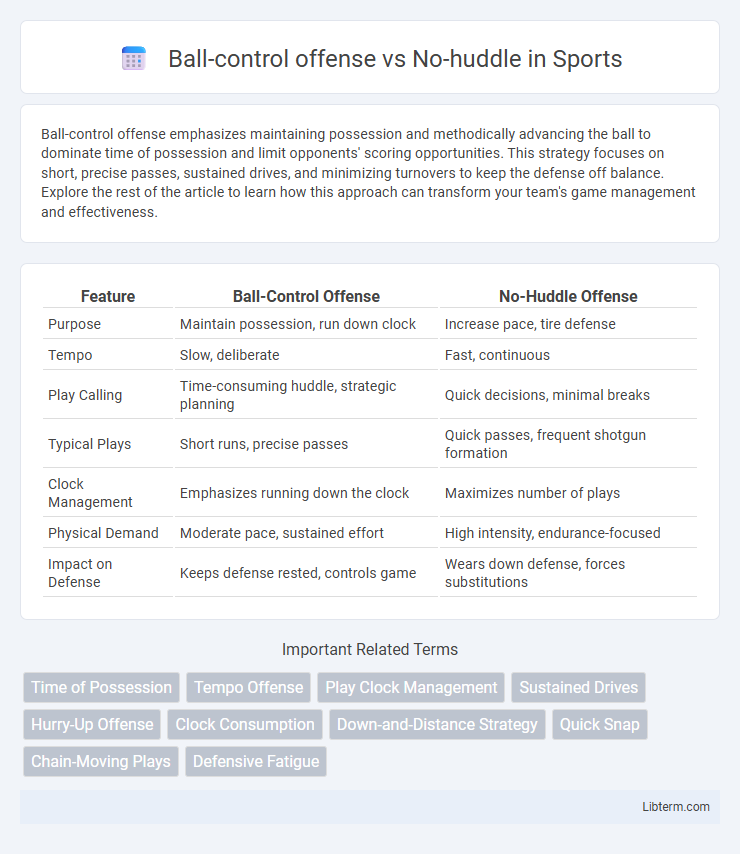Ball-control offense emphasizes maintaining possession and methodically advancing the ball to dominate time of possession and limit opponents' scoring opportunities. This strategy focuses on short, precise passes, sustained drives, and minimizing turnovers to keep the defense off balance. Explore the rest of the article to learn how this approach can transform your team's game management and effectiveness.
Table of Comparison
| Feature | Ball-Control Offense | No-Huddle Offense |
|---|---|---|
| Purpose | Maintain possession, run down clock | Increase pace, tire defense |
| Tempo | Slow, deliberate | Fast, continuous |
| Play Calling | Time-consuming huddle, strategic planning | Quick decisions, minimal breaks |
| Typical Plays | Short runs, precise passes | Quick passes, frequent shotgun formation |
| Clock Management | Emphasizes running down the clock | Maximizes number of plays |
| Physical Demand | Moderate pace, sustained effort | High intensity, endurance-focused |
| Impact on Defense | Keeps defense rested, controls game | Wears down defense, forces substitutions |
Introduction to Ball-Control Offense and No-Huddle Strategies
Ball-control offense emphasizes sustained possession through short, high-percentage passes and running plays, minimizing turnovers and managing the game clock effectively. No-huddle strategies accelerate the pace, preventing defensive substitutions and exploiting mismatches by maintaining a rapid, continuous offensive tempo. Both approaches offer tactical advantages: ball-control limits opponent opportunities, while no-huddle pressures defenses and creates dynamic game flow.
Core Principles of Ball-Control Offense
Ball-control offense emphasizes time management, precise execution, and sustaining long drives to limit opponent possessions and control game tempo. Core principles include effective run-pass balance, high third-down conversion rates, and minimizing turnovers through disciplined play. By maintaining possession and shortening the defense's time on the field, teams enhance their scoring opportunities while dictating the game's rhythm.
Key Elements of the No-Huddle Offense
The no-huddle offense emphasizes rapid tempo, minimizing the time between plays to prevent defensive substitutions and exploit mismatches. Its key elements include quick decision-making by the quarterback, efficient communication through hand signals or code words, and a streamlined playbook tailored for fast execution. By maintaining an aggressive pace, teams wear down defenses and generate opportunities for big plays.
Time of Possession: Stretching vs Shortening the Game
The ball-control offense emphasizes maximizing time of possession by methodically running down the clock through sustained, high-percentage plays, effectively stretching the game to limit opponents' opportunities. In contrast, the no-huddle offense aims to shorten the game by rapidly increasing the pace and frequency of plays, minimizing the defense's rest and maximizing the number of possessions. Time of possession metrics reveal that ball-control strategies often result in prolonged drives and lower total play counts, whereas no-huddle approaches create quick scoring opportunities and higher play counts despite shorter possession durations.
Player Roles and Required Skills in Both Systems
Ball-control offense emphasizes time of possession through precise passing, strong blocking, and disciplined route running, requiring players with exceptional ball security, patience, and physicality. In contrast, the no-huddle offense demands quick decision-making, rapid communication, and high stamina, relying on players who excel in speed, agility, and mental acuity to execute fast-paced plays effectively. Both systems necessitate specialized skills tailored to their tempo and strategic objectives, with quarterbacks and receivers in no-huddle offenses prioritizing rapid reads and adaptability, while ball-control offenses focus on sustained drives and methodical execution.
Tempo, Rhythm, and Game Flow Impact
Ball-control offenses emphasize a slow tempo and deliberate rhythm to manage game flow and limit opponent possessions, enhancing clock management and reducing turnover risk. No-huddle offenses accelerate tempo with rapid play execution, disrupting defensive setups and increasing the number of plays, which can tire out opponents and create scoring opportunities. The contrast between these strategies affects game flow by either controlling the pace to maintain possession or speeding it up to maximize scoring chances.
Defensive Implications: Fatigue and Adjustments
Ball-control offenses emphasize sustained possession, forcing defenses to stay on the field longer, increasing player fatigue and reducing overall effectiveness in late-game scenarios. No-huddle offenses increase tempo and limit defensive substitutions, demanding quicker adjustments and versatility from defenders to prevent mismatches and maintain coverage integrity. Defenses facing these contrasting styles must manage energy reserves strategically while adapting in real time to either prolonged drives or rapid play sequences.
Situational Effectiveness: When to Use Each Offense
Ball-control offense excels in preserving possession and managing the clock during situations requiring time management, such as protecting a lead late in the game or minimizing opponent possessions. No-huddle offense thrives in scenarios demanding rapid scoring and maintaining defensive confusion, ideal for teams needing quick points or facing tired, substitution-limited defenses. Coaches strategically select ball-control to sustain momentum and minimize risk, while deploying no-huddle to increase tempo and exploit mismatches under pressure.
Historical Successes and Famous Examples
Ball-control offense, exemplified by the 1970s Pittsburgh Steelers and their methodical drives, emphasizes time of possession and minimizing turnovers to wear down defenses. The no-huddle offense gained prominence with the 1990s Buffalo Bills and their "K-Gun" attack, using rapid play sequences to exploit defensive mismatches and control game tempo. Both strategies have shaped NFL history by demonstrating unique ways to dominate possession and dictate game flow.
Choosing the Right Offense for Your Team
Ball-control offenses emphasize time of possession by utilizing short, high-percentage passes and a strong running game to minimize turnovers and wear down defenses, making them ideal for teams with disciplined quarterbacks and strong offensive lines. No-huddle offenses prioritize tempo and exploiting defensive mismatches, utilizing quick snaps and frequent substitutions to keep opponents off balance, which benefits teams with fast receivers and versatile playmakers. Selecting the right offense depends on your team's skill set, emphasizing ball control to dominate clock management or no-huddle to maximize speed and aggression on the field.
Ball-control offense Infographic

 libterm.com
libterm.com